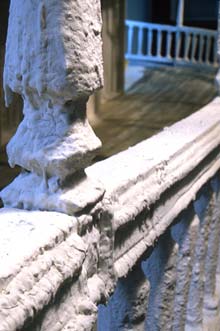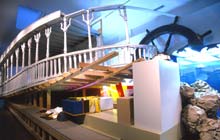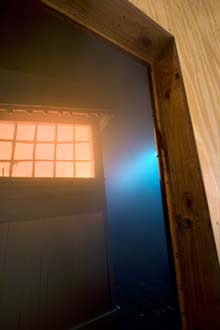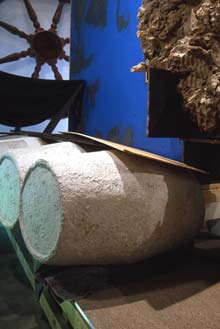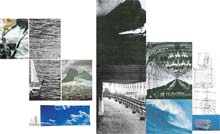 |
   |
| Michael Jones McKean Riverboat Lovesongs for the Ghost Whale Regatta September 1 - October 21, 2006 Describing his apprenticeship years spent on a Mississippi riverboat, Mark Twain observed: "It was plain that I had got to learn the shape of the river in all the different ways that could be thought of,-upside down, wrong end first, inside out, fore-and-aft, and 'thortships,'-and then know what to do on gray nights when it hadn't any shape at all." In time Twain came to memorize each aspect of the waterway's span, to read every nuance of current, to gauge any shift in weather. "But I had lost something, too," he wrote with regret. "I had lost something which could never be restored to me while I lived. All the grace, the beauty, the poetry had gone out of the majestic river!"i McKean sets the stage at Grand Arts by placing a mammoth industrial fan on a second-floor balcony, focused on the entrance, immediately confronting the viewer with a gust of wind. The main gallery space is dominated by a segment of the promenade deck of a Mississippi riverboat, specifically a paddlewheel steamboat circa 1860. Spanning the long entry wall of the gallery, it is both a convincing recreation and clearly jerry-built and insubstantial. Forced perspective gives the initial illusion of a 100-foot craft squeezed into a 40-foot space, an illusion which gradually collapses as the viewer enters into the gallery. Through this mise-en-scène, McKean resurrects and reclaims a potent symbol of U.S. nationhood. Now surviving only as a vehicle of entertainment for tourists and gamblers, the paddlewheel steamboat was the most powerful means of industrial transport in mid-19th-century America. In the decades before the railroad encompassed the continent, it was inextricably tied to dreams of manifest destiny and the practical needs of western expansion. These craft plied their trade from New Orleans to St. Paul, as well as across the Missouri, and were perhaps best memorialized by Twain as "a new and marvelous world."ii Driven by volatile boiler engines, they were also vulnerable to fire and explosion; Twain's brother fell victim to such an accident in 1858. The prow of McKean's riverboat breaks onto a second stage in the gallery, which serves as a platform for deconstructing this narrative. Additional props are provided, including hand-made costumes which suggest the somewhat dandified attire suitable to a 19th-century riverboat pilot and all-weather oilskins of the sort donned by the crew of a clipper ship in the face of a storm. A steering wheel over nine-feet high and a three-foot paddlewheel introduce disconcerting shifts in scale, further destabilizing the tableau. A suite of gilded but awkwardly executed items-a banjo, a jug, spoons, a trumpet, a saxophone, a conquistador's helmet, and a harpoon-both place and displace the story still further, summoning up not only Twain's contemporaries, but also the jazz tradition that came to life along the banks of the Mississippi, the expeditions of Hernando de Soto (buried in the Mississippi in 1542), and Ahab's pursuit of the ghostly white sperm whale, Moby Dick. At the same time, McKean grounds the installation in a more insistent present. Referencing the clean Minimalism and process strategies of the 1960s and '70s, the platform serves as a support for a bank of fluorescent lights, a clear acrylic tank filled with water, and a mountain of raw clay. Among the items sunk within the tank is a model of the Mariana Trench, the world's nethermost point, which reaches a depth of over 36,000 feet off the coast of Japan. McKean expands further upon the theme of peril at sea in the second, smaller gallery at Grand Arts. Constructed as a self-contained room within the gallery itself, this segment of the installation presents a model of a ship's pilot house, supported on a rocking platform, drenched by sheets of rain. Again, illusion and actuality are brought into play as McKean employs forced perspective and theatrical lighting, while leaving evident the pump, water tank, fog machine, dehumidifier, and motors necessary to support this installation. Opposite this structure, at the rear of the gallery space, is an absurdly overscale bank of speakers and amplifiers, which like the fan at the exhibition's entrance stand in for the forces of nature. Tuned to a low hum, once a day this "boom box" plays Albert Ayler's solo from the funeral of John Coltrane. A primal cry, it ends with Ayler's saxophone assuming an almost human wail of sorrow. Four years after this bootlegged recording was made, Ayler's body was found drowned in New York's East River. Donald Crowhurst is perhaps the most elusive presence in this installation, alluded to in the title rather than in the materials in the gallery. An amateur sailor, he competed in the 1968-69 Golden Globe Race, aiming to establish a record for swiftest solo circuit around the world. He chose to sail in an untested trimaran, Teignmouth Electron, and after sending false reports of his progress around the globe, vanished. His ship was discovered adrift, and only his logbook was testament to his growing alienation as he failed to keep pace: "God's clock is not the same as our clock. He has an infinite amount of 'our' time." Crowhurst added as his final entry, "It is finished, it is finished, it is the mercy."iii Other voyagers hover at Crowhurst's side. McKean has cited the specters of Jason, Odysseus, Moses, Lewis and Clark, and Indiana Jones while discussing the work in process, and he has deliberately resisted resolution. "This kind of inquiry doesn't attempt to smooth out complexity, but instead indulges in it through a kind of sculptural mediation," McKean has stated. "For me this practice speaks to the messiness of experience, a notion that feels simultaneously beautiful, incongruent, and distant." Concurrent with Riverboat Lovesongs for the Ghost Whale Regatta, McKean has been engaged with a second undertaking, The Great Circuit Project. With the support of Grand Arts and the University of Kansas' Geography and Cartographic Departments, McKean has mapped, in his words, "the longest possible straight-line route around the earth, beginning and ending in the same place." Impossible to imagine fully, let alone represent within the confines of a gallery, McKean's Great Circuit offers a telling counterpoint to the Ghost Whale Regatta. The installation can be understood as an act of ventriloquism, with historic, literary, and mythic protagonists ghosting for the artist; the Great Circuit is an invented expedition, conceived by McKean for a planet already comprehensively surveyed, measured, and analyzed. It is an attempt to approach the infinite, for the line must always shift in time as patterns of erosion reshape the planet's surface, creating a trail of most resistance rather than a path of greatest expedience. McKean's odysseys address one of the central myths of Modernism: the search for the new. Framed as a quest in both literature and the visual arts, Modernism's pioneers envisioned a revolutionary frontier, best discovered through untapped reserves of the self. Famously challenged by Rosalind Krauss in her essay "The Originality of the Avant-Garde," this endeavor seemed to have come to an end by 1980, like Twain's Mississippi, its parameters navigated and exhausted.4 While willing to acknowledge that many modernisms may take the place of a single unified history, McKean has recovered the essential poetry of this myth. Much as Pierre Huyghe, Tacita Dean, and Matthew Barney, among others, have replayed this notion of quest in recent works, McKean deliberately crosses the line between the artificial construct and objective reality. However, he brings to his Grand Arts installation a fresh sense of romantic optimism: "The project in a way acts as a love song, like it's trying desperately to pronounce these things that are really difficult and impossible. In this way, Riverboat Lovesongs for the Ghost Whale Regatta tries to point to things outside of itself, to risk and then to fail in it's own object-ness, it's own base materiality." Indeed, this enterprise might falter, the sailor may be lost at sea, the ghost whale will elude capture. Yet McKean's spirit of adventure will carry us forward. Alison de Lima Greene 1Mark Twain, Mississippi Writings: Life on the Mississippi (New York: Library of America, 1982), 461. 2 Ibid., 284. 3British artist Tacita Dean has also explored Donald Crowhurst's saga in a number of works. See Tacita Dean, Teignmouth Electron. London: National Maritime Museum, 1999. Both quotations from Crowhurt's logbook are taken from this unpaginated publication. 4Rosalind E. Krauss, "The Originality of the Avant-Garde," October 18 (Fall 1981); reprinted in The Originality of the Avant-Garde and Other Modernist Myths (Cambridge, Massachusetts, 1985), 151-170. ----- |
